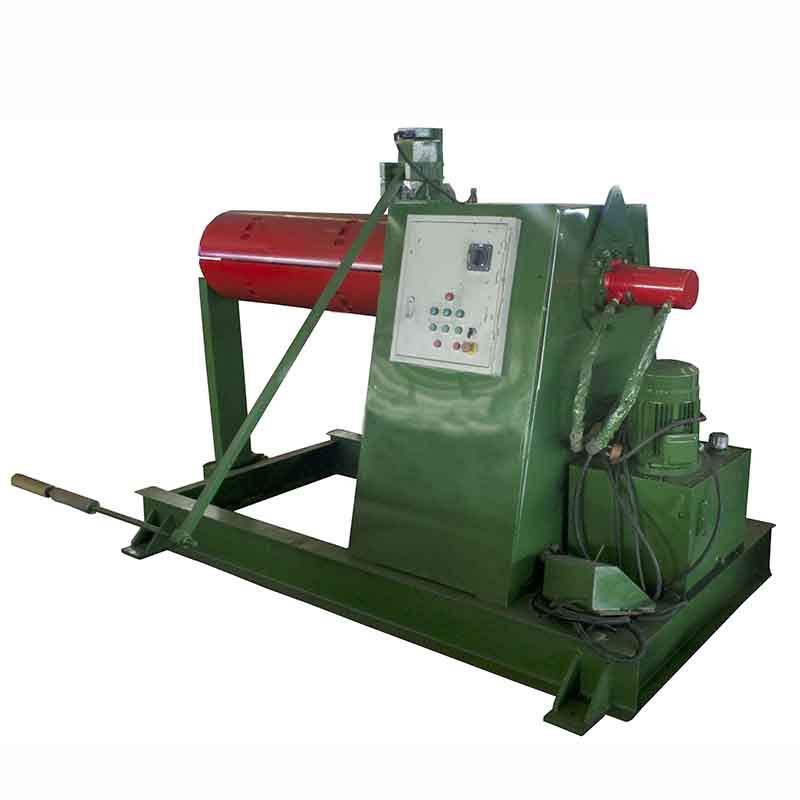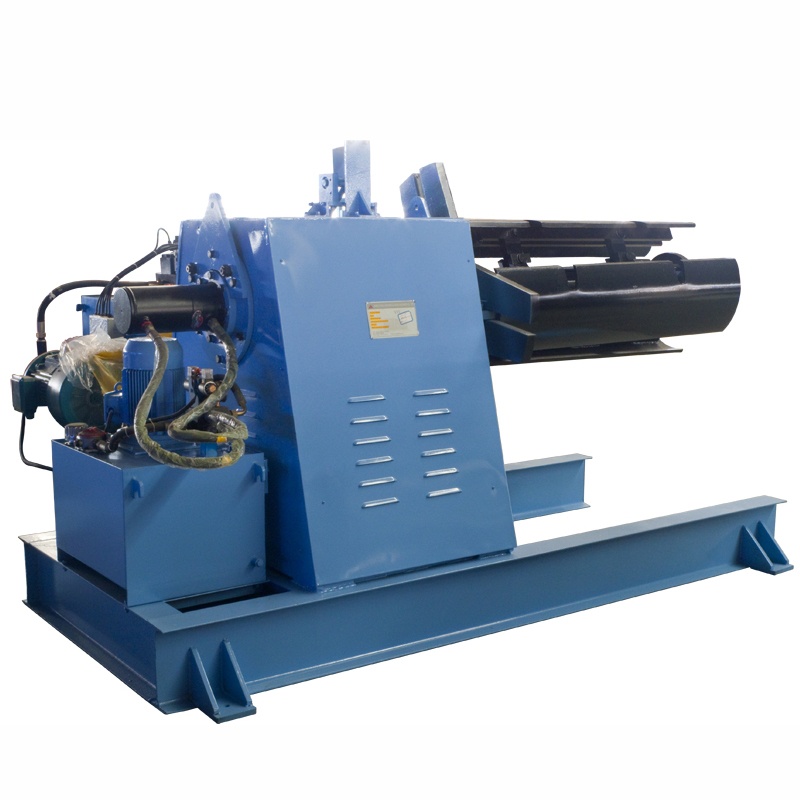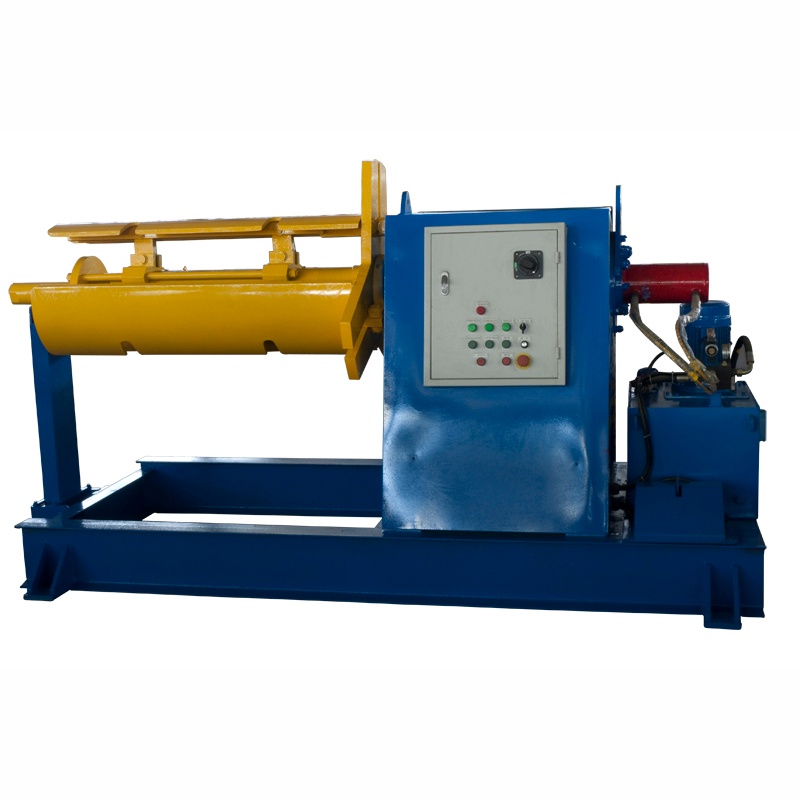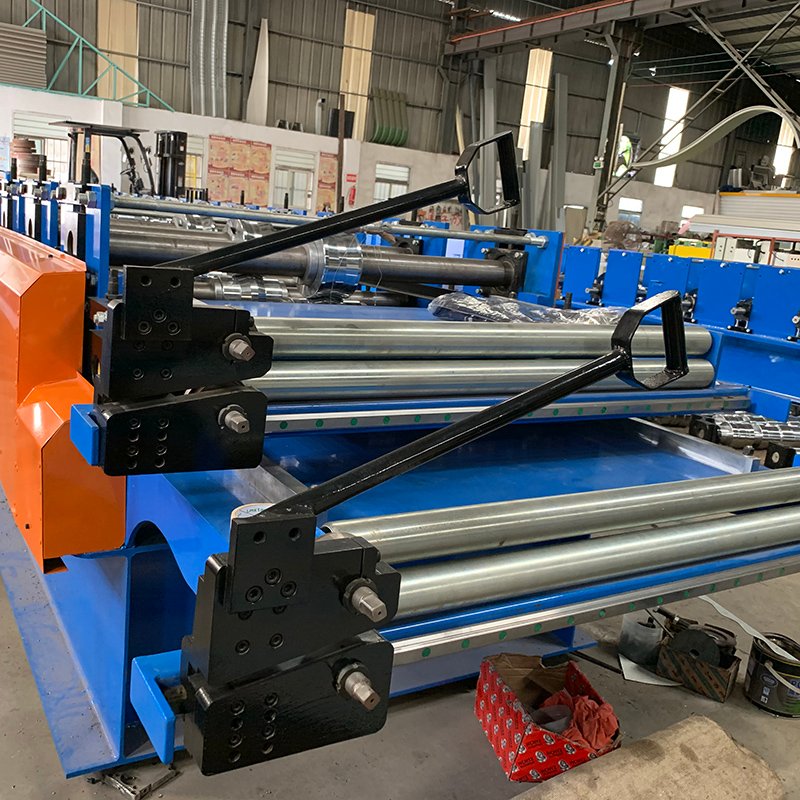Hydraulic Uncoiler is a special equipment for metal sheet leveling. It is used for leveling steel sheets and uneven sheets. It can be composed of uncoiling, leveling, shearing production lines and other sheet product production lines according to relevant configurations. Suitable for machinery, vehicles, metal products, household appliances, steel structures, decoration and other industries. The reel of the Decoiler is expanded and opened by a hydraulic motor, with large and stable transmission force and low speed requirements. However, when the decoiler rotates, the speed is fast, and the hydraulic motor cannot reach its speed, and the motor reducer is used as the transmission mechanism. Common hydraulic decoilers are 5 tons, 10 tons, 15 tons and special customized models.
1. Introduction to Hydraulic Uncoilers:
In the realm of metal forming and coil processing, the hydraulic material uncoiler stands as a cornerstone of efficiency, seamlessly unwinding coiled metal and preparing it for further processing. This article delves into the intricate details of the hydraulic decoiler, exploring its attributes, functions, and the myriad advantages it brings to industrial processes.
2. Attributes of Hydraulic Decoilers:
A hydraulic uncoiler boasts several key attributes that contribute to its efficacy in metal processing operations. Firstly, it is equipped with a robust hydraulic system that facilitates smooth and controlled unwinding of coils. This hydraulic mechanism ensures precision and reliability in the uncoiling process, minimizing the risk of material distortion or damage.
Additionally, hydraulic decoilers are designed with a sturdy frame and a set of gripper arms that securely hold the coil. The gripping mechanism is adjustable, accommodating various coil sizes and preventing slippage during operation. This adaptability makes hydraulic decoilers versatile, and suitable for a range of materials and coil dimensions.
3. Functions of Hydraulic Uncoilers:
The primary function of a hydraulic material uncoiler is to unwind coiled metal efficiently, providing a continuous feed for downstream processing equipment. The hydraulic system plays a pivotal role in controlling the speed and tension during the unwinding process, ensuring a steady and controlled material flow.
Hydraulic material uncoilers are often equipped with features such as automatic coil centering and alignment, further streamlining the setup process. This automation enhances the overall efficiency of the metal processing line, reducing manual intervention and the associated risk of errors.
4. Advantages of Hydraulic Decoilers:
The advantages of incorporating hydraulic uncoilers into metal processing operations are multifaceted. One of the key benefits is enhanced productivity. The seamless and automated operation of hydraulic material uncoilers significantly reduces downtime between coil changes, maximizing the overall output of the production line.
Furthermore, the precision offered by the hydraulic system contributes to improved material utilization. Minimizing material waste is crucial in modern manufacturing, and hydraulic material uncoilers excel in optimizing the usage of coiled metal, leading to cost savings and sustainability benefits.
In terms of versatility, hydraulic decoilers can handle a wide range of coil materials, including steel, aluminum, and other metals. This adaptability makes them suitable for diverse industries, from automotive manufacturing to construction, where different materials may be utilized in the production process.
Another notable advantage is the safety aspect. Hydraulic material uncoilers are designed with safety features such as emergency stop mechanisms and overload protection. These features mitigate the risk of accidents and equipment damage, ensuring a secure working environment for operators.
5. Innovations in Hydraulic Uncoiler Technology:
As technology evolves, so does the landscape of industrial equipment. Hydraulic decoilers have witnessed innovations in recent years, contributing to their efficiency and reliability. Advanced control systems, such as programmable logic controllers (PLCs), enable precise control over the unwinding process, allowing for customization based on specific production requirements.
Additionally, some hydraulic material uncoilers come equipped with sensors and monitoring devices that provide real-time feedback on tension, speed, and coil alignment. This data can be utilized for process optimization, preventive maintenance, and quality control, further enhancing the overall efficiency of metal processing operations.
6. Applications of Hydraulic Uncoilers:
The versatility of hydraulic material uncoilers makes them indispensable in various industries. In metal forming applications, hydraulic decoilers are commonly used in roll forming lines, stamping presses, and other machinery where a continuous feed of material is required.
The automotive industry benefits from hydraulic material uncoilers in the production of car body components, ensuring a consistent supply of metal for stamping and forming processes. Similarly, in the construction sector, hydraulic uncoilers play a crucial role in the manufacturing of components for structures and infrastructure projects.
7. Considerations for Choosing a Hydraulic Decoiler:
When considering the adoption of a hydraulic decoiler in a metal processing facility, several factors come into play. Coil weight and dimensions, material specifications, and production volume are critical considerations. Additionally, assessing the level of automation required and the compatibility with existing equipment is essential for seamless integration into the production line.
Reliability and after-sales support from the equipment manufacturer should also be taken into account. Choosing a reputable supplier ensures not only the quality of the hydraulic uncoiler but also ongoing assistance in terms of maintenance, troubleshooting, and potential upgrades.
8. Maintenance and Care:
Maintenance is a crucial aspect of ensuring the longevity and optimal performance of a hydraulic uncoiler. Regular inspection of hydraulic components, such as hoses and cylinders, is essential to identify and address potential issues before they escalate. Lubrication of moving parts and routine checks on the gripping mechanism contribute to the overall reliability of the system.
Additionally, operators should be well-trained in the proper use and maintenance of the hydraulic decoiler. Following manufacturer guidelines and recommended maintenance schedules ensures that the equipment operates at peak efficiency throughout its service life.
9. Environmental Considerations:
In the context of modern manufacturing, environmental sustainability is a key consideration. Hydraulic uncoilers, when designed with energy-efficient features, contribute to reducing the overall carbon footprint of metal processing operations. Energy recovery systems and smart control technologies can optimize power consumption, aligning with the growing emphasis on environmentally friendly industrial practices.
Furthermore, the choice of hydraulic fluids can impact the environmental impact of the equipment. Using biodegradable or environmentally friendly hydraulic fluids aligns with sustainability goals and regulatory requirements.
10. Future Trends in Hydraulic Uncoiler Design:
The future of hydraulic decoiler design is likely to witness continuous advancements driven by technological innovation. Integration with Industry 4.0 concepts, such as the Industrial Internet of Things (IIoT), may become more prevalent. This could involve real-time data monitoring, predictive maintenance capabilities, and remote access for diagnostics and control.
Efforts to enhance automation and reduce manual intervention in coil changeovers are expected to be a focal point of future designs. Smart features that enable the hydraulic uncoiler to adapt to different coil sizes and materials seamlessly will contribute to further efficiency gains.
Conclusion:
In conclusion, the hydraulic Uncoiler emerges as a vital component in the landscape of metal processing, offering a blend of precision, efficiency, and versatility. Its attributes, functions, and advantages position it as a catalyst for enhanced productivity and material utilization in various industrial applications. As technology continues to propel manufacturing forward, the hydraulic decoiler stands at the forefront, unlocking new possibilities for streamlined and optimized metal processing operations.

Specifications/Technical parameters
|
Hydraulic Un-coiler with coil car (SUPER QUATLIY) |
5TON/10TON/15TON/20TON |
|
Specification as 10ton capacity |
Hydraulic system expand coil inner hole, Pump motor: 3KW Frequency Inverter to regulate turning speed, Motor: 5.5KW Coil Inner-diameter=510±30mm. Coil Outer-diameter Max. 1200mm; Taper wedge expanding system Load Capacity: Max. 10 Tons; Coil Width Max. 1250mm; Support arm equipped at the end of the main shaft, max. Capacity: 10Tons Maintain arm on the top, to avoid coil become loose when stop to be packed. The arm to be driven by pneumatic cylinder, manual control The air supplier should be provide by the user Automatic stopping device with limited switch as assistance to control stop/star rotation With coil car – The original design Up/Down stroke of Coil Car: Max. 300mm; Forward/backward stroke of Coil Car: Max. 2000mm COMMENTS: Hydraulic part we adopt YUKEN brand. |
|
SERVICE AFTER SELL |
In correct operation & maintaining, the machine is guaranteed for one year since leaving our factory excludes the electric elements. If installation is needed, RELIANCE (the seller) will dispatch a technician to the buyer’s factory abroad to assist regulating the machine with $100 salary per day. The buyer should assist RELIANCE to get the Chinese technician’s visa and should pay for the roundtrip air ticket and the local accommodation. |
|
ELECTIRC STANDARD |
380V 50HZ 3PH OR CUSTOMZIED REQUEST |












